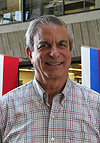Assistant Director Jeffrey Appel retires this week
 |
|
Jeffrey Appel
|
After serving Fermilab for nearly 37 years as a physicist and administrator, Jeffrey Appel is retiring as Assistant Director for the Program Planning Office.
His last day in the directorate is July 13, but it won't be his last day at the laboratory.
"I'll be back to help finalize the CDF papers," he said. "It's just for the pleasure of working with the physics results."
The pleasure has spanned research in accelerators, detectors and computing. As a scientist, Appel was a collaborator on the E-288 experiment, which made the discovery of the bottom quark in 1977. He later investigated heavy quark physics at the Tagged Photon Laboratory, as well as at the BTeV and CDF experiments. At the TPL, he served as spokesperson of E-769 and co-spokesperson of E-791.
"One of the pleasures of being at Fermilab is being able to participate in so many different things," Appel said.
The variety of his experiences, both scientific and non-technical, made him an excellent fit for the Program Planning Office, where he has coordinated the research of the many experiments and accelerator studies according to the laboratory's priorities.
"He has deep and broad knowledge of the science, the experiments, the users and the accelerators, which he uses to help us mount the optimal program here at the lab," said Associate Director for Particle Physics Greg Bock.
In addition to researching particle physics, Appel has expanded opportunities for students, teachers and the public to better understand science.
Soon after he started at the laboratory, Appel initiated the Bicentennial Lecture Series, a Friday night series of science and humanities talks. They attracted speakers such as Jane Goodall and Carl Sagan. For 10 years, Appel served as head of the Auditorium Committee. He also co-directed the first Hadron Collider Physics Summer School, initiated the first summer teacher-hiring program at Fermilab and was a member of the Board of Trustees for Fermilab Friends of Science Education.
Appel has also held several leadership roles at Fermilab, including head of the former Computing Department and of the former Physics Section. He served as project manager for the Central Computing Upgrade Project, a $25 million endeavor that led to the construction and operation of the Feynman Computing Center.
"I've worried about the bureaucracy, the science, the field and the laboratory and tried to do things that are useful wherever I could," he said.
"Jeff will be sorely missed," said Fermilab Director Pier Oddone. "He is imperturbable under the many conflicting demands of experimenters and has optimized our program over many years."
Appel retires from Fermilab as an American Physical Society Fellow with more than 250 papers to his name. He plans to remain involved in science after retiring, maintaining a connection with the laboratory.
"Working here is working with some wonderful people," Appel said. "That isn't just a platitude."
—Leah Hesla
|